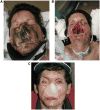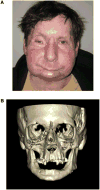Face allotransplantation and burns: a review
- PMID: 22274632
- PMCID: PMC3438348
- DOI: 10.1097/BCR.0b013e318247eb06
Face allotransplantation and burns: a review
Abstract
Burns may represent one of the main indications for face allotransplantation. Severely disfigured faces featuring a devastating appearance and great functional impairments are not only seen as burn sequelae but also occur as a result of other traumatic injuries, oncological surgical resections, benign tumors (eg, neurofibromatosis), and major congenital malformations. To date, 20 human face composite tissue allotransplants have been performed with success. Despite the initial scepticism about its applicability, due mainly to ethical and technical reasons, the previous worldwide cases and their associated positive outcomes, including acceptable immunosuppressive regimens, excellent aesthetic and functional results, and good psychological acceptance by the recipient, enable the conclusion that face composite tissue allotransplantation has become another therapeutic strategy in the reconstructive surgical armamentarium, which bears special consideration when dealing with severely disfigured burned patients. The aim of this review is to describe the basics of face composite tissue allotransplantation and give an overview of some of the cases performed until now, with special attention paid to debating the pros and cons of its applicability in burn patients.
Conflict of interest statement
Figures


References
-
- Lee WPA, Yaremchuk MJ, Pan YC, et al. Relative antigenicity of components of a vascularized limb allograft. Plast Reconstr Surg. 1991;87:401–11. - PubMed
-
- Murray JE. Organ transplantation (skin, kidney, heart) and the plastic surgeon. Plast Reconstr Surg. 1971;47:425–31. - PubMed
-
- Madani H, Hettiaratchy S, Clarke A, Butler PEM. Immunosuppression in an emerging field of plastic reconstructive surgery: composite tissue allotransplantation. J Plast Reconstr Aesthet Surg. 2008;61(3):245–9. - PubMed
-
- Petruzzo P, Kanitakis J, Badet L, et al. Long-term follow-up in composite tissue allotransplantation: In-depth study of five (hand and face) recipients. Am J Transplant. 2001;11:808–16. - PubMed
-
- Hettiaratchy S, Randolph MA, Petite F, et al. Composite tissue allotransplantation: a new era in plastic surgery? Br J Plast Surg. 2004;57(5):381–91. - PubMed
Publication types
MeSH terms
Substances
Grants and funding
LinkOut - more resources
Full Text Sources
Medical
Research Materials
Miscellaneous

